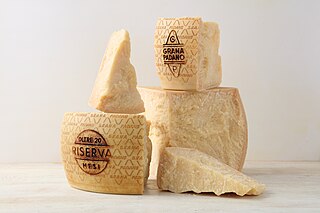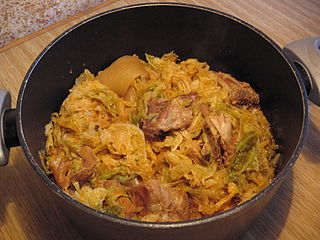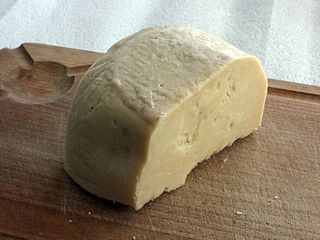
Mozzarella is a semi-soft non-aged cheese prepared by the pasta filata ('stretched-curd') method with origins from southern Italy.

Pecorino romano is a hard, salty Italian cheese made from sheep's milk, often used for grating over pasta or other dishes. The name pecorino simply means 'ovine' or 'of sheep' in Italian; the name of the cheese, although protected, is a description rather than a brand: [formaggio] pecorino romano simply means 'sheep's [cheese] of Rome'.

Parmesan is an Italian hard, granular cheese produced from cow's milk and aged at least 12 months or, outside the European Union and Lisbon Agreement countries, a locally produced imitation.

Gorgonzola is a veined protected designation of origin (PDO) Italian blue cheese, made from unskimmed cow's milk. It can be buttery or firm, crumbly and quite salty, with a "bite" from its blue veining. Outside the European Union and the countries recognizing the geographical origin protection, the name Gorgonzola can legally be used for similar cheeses, with only the full Italian name unambiguously referring to PDO Gorgonzola. It is a famously pungent cheese.

Goat cheese, goat's cheese or chèvre is cheese made from goat's milk. Goats were among the first animals to be domesticated for producing food. Goat cheese is made around the world with a variety of recipes, giving many different styles of cheeses, from fresh and soft to aged and hard.

Asiago is a cow's milk cheese, first produced in Asiago in Italy, that can assume different textures according to its aging, from smooth for the fresh Asiago to a crumbly texture for the aged cheese. The aged cheese is often grated in salads, soups, pastas, and sauces while the fresh Asiago is sliced to prepare panini or sandwiches; it can also be melted on a variety of dishes and cantaloupe. It is classified as a Swiss-type or Alpine cheese.

Ricotta is an Italian whey cheese made from sheep, cow, goat, or Italian water buffalo milk whey left over from the production of other cheeses. Like other whey cheeses, it is made by coagulating the proteins that remain after the casein has been used to make cheese, notably albumin and globulin.

Grana Padano is a cheese originating in the Po Valley in northern Italy. It is similar to Parmesan but with less strict regulations governing its production. This hard, crumbly-textured cheese is made with unpasteurized cows' milk that is semi-skimmed. To preserve the authenticity of the manufacturing processes and raw materials used to make this cheese, Grana Padano was registered as Geographical Indication in Italy in 1954, and as a European Union protected designation of origin (PDO) in 1996. Outside of the EU, its name is protected in several other countries based on the Lisbon Agreement and bilateral agreements.

Caprino is an Italian cheese traditionally made from whole or skimmed goat's milk. The name of the cheese derives from the Italian word for goat, capra. With modern methods of production, the cheese is made from cow's milk as well or a combination of both cow's and goat's milks. The two major styles of caprino are fresco ("fresh") and stagionato ("aged").

Castelmagno (DOP) is an Italian cheese originating from the Piedmont region. It has a protected designation of origin status in the European Union.

The Italian cheese Bra originates from the town of Bra, in province of Cuneo, in the region of Piedmont.

Montasio is a mountain cheese made from cow's milk produced in northeastern Italy in the regions of Friuli-Venezia Giulia and Veneto.

Lombard cuisine is the style of cooking in the Northern Italian region of Lombardy. The historical events of its provinces and of the diversity of its territories resulted in a varied culinary tradition. First courses in Lombard cuisine range from risottos to soups and stuffed pasta, and a large choice of second-course meat or fish dishes, due to the many lakes and rivers of Lombardy.

Valtellina Casera is a cheese made from semi-skimmed cows' milk in the northern Italian province of Sondrio. Its origins date back to the sixteenth century and it is much used in the cuisine of the Valtellina: particularly in dishes based on buckwheat flour such as pizzoccheri and sciatt.

Formaggio di fossa is an Italian cheese originating from Sogliano al Rubicone, in the province of Forlì-Cesena, Emilia-Romagna.

Silter is an Italian hard cheese made within the Lombardy region, around province of Brescia and surrounding areas, and traditionally produced with unpasteurised cows milk during summer months and September, is brined, and aged for a minimum of 6 months.
Pecorino di Carmasciano, or simply Carmasciano, is an Italian cheese of the pecorino family of cheeses made from sheep's milk. It has been recognized since 2009 by the Italian Ministry of Agricultural, Food and Forestry Policies as a prodotto agroalimentare tradizionale (PAT). Pecorino di Carmasciano was featured at Expo 2015 in Milan.

Puzzone di Moena, is an Italian PDO cheese, with a washed rind, fat and semi-hard pressed paste made from raw cow's milk.
 Wrapped Bitto
Wrapped Bitto
















